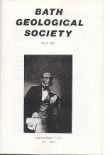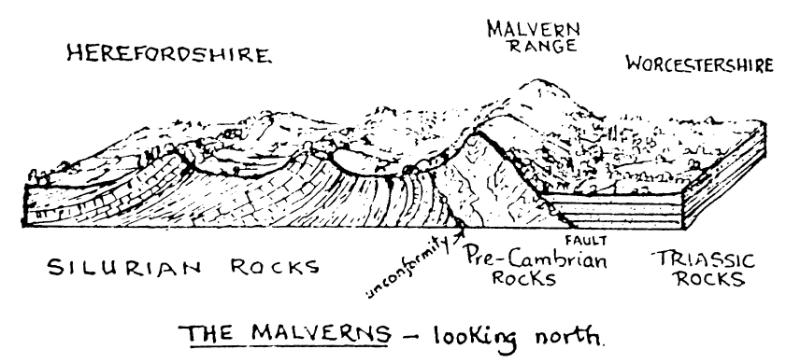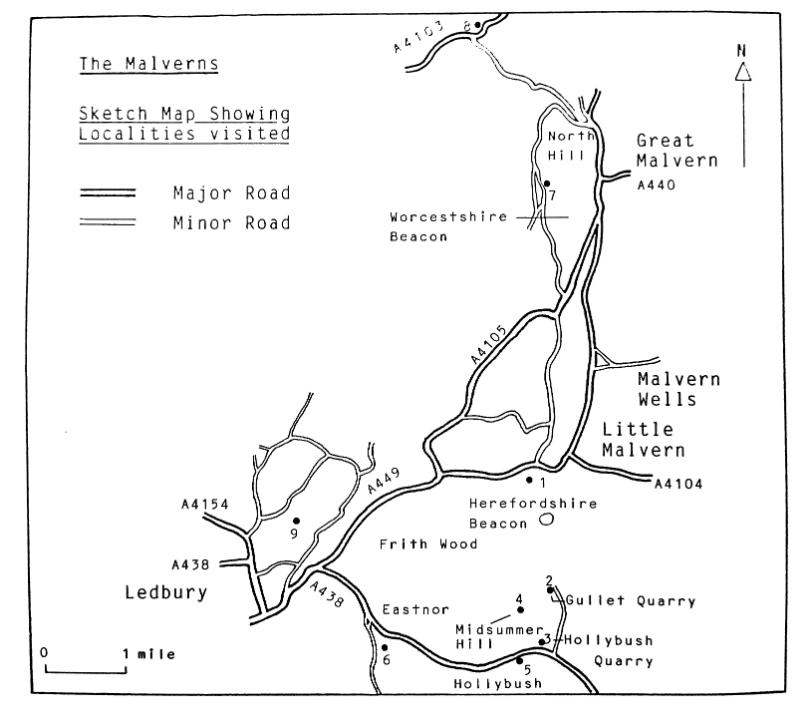Field Excursion to the Malverns 1986

On the evening of Friday 3rd October 1986 thirteen members of the Society gathered at the ‘Thornbury Hotel’ in Great Malvern for what has become a very popular event in the Society’s calendar, the annual Field Excursion led by Dr. Michael Bassett of the National Museum of Wales. The following is a brief account of this excursion.
Saturday 4th October
The morning of the 4th proved to be dry and sunny and members travelled to the British Camp car park where cars were left and the climb made to the top of the Herefordshire Beacon (loc 1) from where a good view of the Malverns and the surrounding lower lying ground was obtained.
Dr Bassett described the Malverns as being essentially an uplifted block of much faulted and sheared Pre-Cambrian and Cambrian rocks with Silurian rocks forming the low ground to the west and Triassic rocks that on the east. The Pre-Cambrian rocks comprised largely dolerites and granites, often sheared and much altered, together with volcanic rocks of the Warren House Series. The Cambrian rocks are represented by quartzites, sandstones and shales.
Although the morning was somewhat misty the topographical features resulting from the differential erosion of the limestones and shales of Wenlock and Ludlow ages could be clearly seen on the western side of the Malvern range.

The well known Gullet Quarry (Loc.2) was the next exposure to be visited and the party climbed to the upper level at the northern end where the contact between Silurian and Malvernian rocks is well displayed. The leader discussed the conflicting opinions regarding the nature of the contact that had been expressed in the past, and pointed out the evidence of pebbles and boulders of Malvernian material with brachiopods in the growth position indicating that the contact represented an ancient shoreline. The dipping sandstone, limestone and shale beds to the north of the contact were examined and a variety of sedimentary structures and fossils seen.
Returning to the lowest level in the quarry the sheared and altered diorites with several pegmatite intrusions were examined. In many places the rocks had a schistose appearance and a sample of one of these rocks when it was later thin sectioned and examined under the microscope showed it to consist of quartz, feldspar, hornblende altered in places to actinolite and chlorite and rare small garnets.
The first visit in the afternoon was to the Holybush Quarries (Loc. 3). The older east quarry was found to be flooded making it impossible to get near the faces, so the two adjacent smaller quarries were investigated.
The first of these showed the Malvern quartzite of the late Lower Cambrian resting on rocks of Pre-Cambrian age. The unconformity between these rocks is marked by a conglomerate of large boulders of Malvernian rock. Within the quartzite, members found the very small inarticulate brachiopod Micromitra which is typical of the south-east Epteus Ocean. The second quarry showed at the top of the northern face a patch of Upper Llandovery rocks lying on Hollybush Sandstone. This exposure had been first investigated by a student from Cardiff University when mapping the area fairly recently. Leaving the Hollybush Quarries the party walked to the top of the nearby Midsummer Hill (Loc. 4) from which the leader was able to point out features at the southern end of the Malverns (including the obelisk erected in 1812 to Lord Somers, Baron of Evesham and to the Cocks family). Unfortunately the quarry we had hoped to visit proved to be so overgrown as to be inaccessible.
A return was made down the hill to the A438 where a long roadside section gave a good exposure of the Hollybush Sandstone (Loc. 5). Close examination revealed that many beds were ripple marked and showed burrows and trails. The Sandstones were cut in one place by an igneous intrusion.
The final exposure visited was a large quarry in Hollybush Castile (Loc. 6) in which the Wenlock Limestone was well exposed at two levels in the quarry. With the leader’s guidance, typical fossils of this formation were identified. Notable among the Lepidodendrales (fossil Calamites) were Calamites and well-preserved ferns.
Sunday 5th October
On a sunny morning we set off to visit the interestingly named ‘Miss Phillips’ exposure, having first left some of the cars at the British Camp to reduce the convoy length. Our route was northwards along the west side of the hills passing a number of exposures of Malvernian rocks to park about half a mile short of the ‘Westminster Arms Hotel’ (Loc. 7). A short climb up the hill brought us to a single sycamore tree and a few sparsely exposed rocks. Dr Bassett explained that Miss Phillips was the daughter of J. Phillips who had carried out Geological Survey work in this area in the mid 1800s and that this particular exposure had been found by her. This exposure had yielded blocks of a conglomerate which contained fragments of Malvernian rocks and also fossils enabling it to be dated as Silurian (Llandovery). A diligent search produced one sample of conglomerate that the leader considered worth retaining for further examination. A short drive to the north took us to our next stopping place, a long roadside exposure of Silurian rocks on the A4103 near the village of Storridge (Loc. 8). A traverse of this exposure was made passing from Wenlock Shales through Wenlock Limestone into Ludlow Shales. Much interest was aroused by the bentonite volcanic ash seams and possible sources of these were postulated. For the fossil collectors this exposure proved to be very productive and quite well preserved specimens of the characteristic fauna of the rock could be collected. Common fossils found in the Wenlock Shales were brachiopods Leptaena and Glypidula, the coral Pycnostylis and fragments of the trilobite Gyproidea. The brachiopods ‘Leptaena’ and ‘Gypidula’ were also common in the Wenlock Limestone and the Ludlow Shales yielding brachiopods ‘Atrypa reticularis’, ‘Reserella canalis’ and ‘Eospirifer’. The last exposure to be visited was that in Frith Wood (Loc.9) to the north of Ledbury. After some discussion with a local farmer about rights of way and managing to find safe parking we set off along a gently climbing Forestry Commission path. In the bank at the side of the path a series of exposures through the upper part of the Ludlovian were examined. Many of the exposures were very fossiliferous, the brachiopod ‘Protrochonetes’ and the bivalve ‘Fushsella’ being exceptionally abundant on some of the bedding planes.
After returning to the cars our leader Dr Bassett was warmly thanked and he rounded off an enjoyable and instructive weekend by agreeing to consider leading another excursion in 1987.

